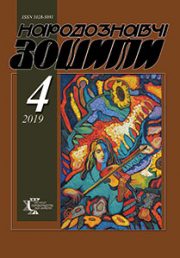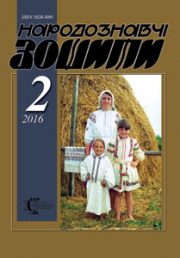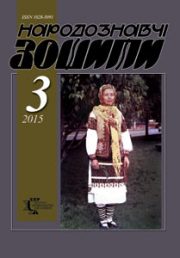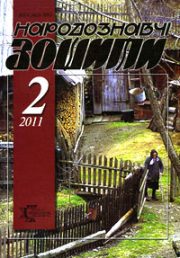The Ethnology Notebooks. 2020. № 1 (151), 220—228
UDK73/76.046.3:27-526.62]:[27-36-057.36:2-185.32-043.865]
DOI https://doi.org/10.15407/nz2020.01.220
MOSKAL Marta
ORCID ID: https://orcid.org/0000-0002-1811-8328
postgraduate, Lviv National Academy of Arts,
Kubiiovych, 38, 79011, Lviv, Ukraine,
artist restorer of II category
Lviv branch of the National Research
Restoration Center of Ukraine (LF NNDRTSU)
Ukrainian Lesya, 10, 79008, m. Lviv, Ukraine
Abstract. Background. Depictions of warrior saints of St. Demetrios of Thessaloniki, St. Eustace Placida, St. Michael the Archangel, St. Theodore of Amasea, St. Theodore Stratelates, St. George, and St. Nicetas appear in Ukrainian art with the adoption of Christianity on our lands. The spreading of their cult plays a crucial role in the life of Ukrainian folk. They were depicted as pedestrian warriors, warriors on a throne, and as horsemen. Warrior saints act as state defenders, evil slayers, and patrons of Kyivan Rus princes and Cossacks army. That is why so much attention was paid to depicting images of warrior saints in different art forms.
Problem Statement. In Ukrainian art history, researchers referred in their studies to certain saints, described the development process of iconography in the context of art styles development, paid attention to some particular art pieces from museum collections and anthologies; however, a complex study of warrior saints depiction in Ukrainian art was not put a focus on. The ones requiring research in particular are the narratives of warrior saints slaying dragons or Satan.
Purpose of the article is to follow the evolution of warrior saints images in Ukrainian art of the ХІІ—ХVІІІ centuries in the narratives of dragon or Satan slaying.
Objectives. The object of the study is the works of Ukrainian sacred art, in which the plot of the struggle of holy warriors with a serpent or Satan is presented.
Methods. The methods of the research are of complex nature and base on a correlation of a number of approaches (structure code, semiotic depiction, hermeneutic, iconological, iconographic).
Result. Based on examples of Ukrainian art of the ХІІ—ХVІІІ centuries, the narrative of warrior saints St. Michael the Archangel, St. George, St. Theodore of Amasea, St. Theodore Stratelates, and St. Nicetas slaying a dragon or Satan was studied. It was concluded that the evil slaying narrative had roots in folklore and also emerged from apocrypha and the Book of Revelation. It was also concluded that the spreading of the dragon slaying narrative was due to historical and political situations happening in our state at that time.
Conclusion. In Ukrainian culture, the emergence of dragon or Satan slaying warrior saints is caused by the spreading of apocrypha in Kyivan Rus and is also linked to the arising of a hero archetype in folk mentality as a fighter against evil and dark forces.
Keywords: warrior saints, serpent, satan, Ukrainian art, Middle Ages, Renaissance, baroque.
Received 24.01.2020
REFERENCES
Kolpakova, N., & Sheyko, V. (Ed.). (2014). The hagiography of St. George in the monuments of the book writing of Byzantium and Kyivan Rus. Kultura Ukrajini (Issue 45, pp. 124—132). Kharkiv [in Ukrainian].
Lihachev, D. (Ed.). (1987). The Dictionary of Scribes and Bookworld of Ancient Russia (Vol. 1) (XI — first half of the XIV century). AN SSSR; IRLI. Leningrad: Nauka [in Russian].
Rozhdestvenskaja, M. (2002). Apocrypha of Ancient Russia. SPb: Amphora [in Russian].
Propp, V. (1973). Cheerfulness of George in the light of folklore. In Folklore and ethnography of the Russian North (Pp. 190—208) [in Russian]..
Tuptalo, D. (2005, September). Life of the Saints (Chetys Miney) (Book І). Lviv: Svichado [in Ukrainian].
Ogienko, I. (Ed.). (2002). The Bible or the Book of Scripture of the Old and New Testaments: from the language of Hebrew and Greek to Ukrainian literally Kyiv: Ukrainian Bible Society. Retrieved from: http://www.bibleonline.ru/bible/ukr/ [in Ukrainian].
Rusko, N. (2016). Archetypes of Galician icons: the philosophical and religious studies context. Bulletin of the Precarpathian University. Philosophical and psychological sciences, 20, 164—169 [in Ukrainian].
Kotlyar, M. (1988). Introduction of Christianity in the Old Russia State. Ukrainian Historical Magazine, 6, 14—25 [in Ukrainian].
Kvytko, A. (2017). Special features of visualization of the archetype of the hero in the secular visual art on the Christian theme. Vaznyk Kazoguki. 4, 101—104 [in Russian].
Archypova, Ye. (1997). Monumental plastic in the Kyiv architecture of the XII century. Archeology, 2, 53—69 [in Ukrainian].
Archypova, Ye. (2003). New researches of ancient monuments of Kyiv. Materials of the scientific conference of the Sofia Kyivska National Reserve (Pp. 40—52). Kyiv [in Russian].
Alpatov, M. (1967). The image of George the warrior in the art of Byzantium and ancient Russia. Studies on the history of Russian art (Pp. 292—317) [in Russian].
Nekrasova, M. (2009). The image of a warrior-horseman — St. George of the snakeburst. His sacred meaning in the art of the Slav peoples as a source of life’s beginnings. Proceedings of the St. Petersburg State University of Culture and Arts (Pp. 15—27)[in Russian].
Zhyshkovich, V. (1999). Plastics of Rus-Ukraine X — the first half of the XIV century. Lviv: Instytut Narodoznavstva NANU; Lvivska bohoslovska akademiia [in Ukrainian].
Sprutta, J. (2013). The history and worship of warriors in the light of Byzantine and Old Russian literary and iconographic sources. Context of rider’s fight with a dragon-hose. Opis rozprawy doktorskiej, Uniwersytet Kardyn№ Stefan Wyszynskiego w Warszawie [in Polish].
Anna Rozycka-Bryzek. (2000). Frescoes in the Chapel of the Lublin Castle. Lublin: Muzeum Lubelskie [in Polish].
Logvin, G., Miliaeva, L., & Svencytska, V. (1976). Ukrainian medieval painting. Kyiv: Art [in Ukrainian].
Kolpakova, N. (2015). St. George in the Galician icon-painting of the XIV—XVIII centuries: iconography and evolution of the image: diss. … candidate of art studies [in Ukrainian].
Moskal, M. (2017). Holy warriors Theodore Tyrone and Theodor Stratilat in the Ukrainian sacral art of the XII—XVIII centuries: iconography and evolution of the image. Vysnyk KDAMD. 3, 130—137 [in Ukrainian].
Makarova, A. (1995). The Light of the Ukrainian Baroque. Kyiv: Art [in Ukrainian].
Skovoroda, G. (1973). Strugle of the Archangel Michael with Satan about this: Is it easy to be good. Complete collection of works (Vol. 2, pp. 59—84) [in Russian].







